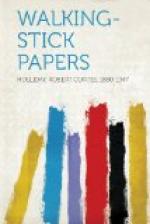“Do you know Chelsea at all?” asks one of them, of an anarchic-looking young man.
Never got back, as I was about to say, from Chelsea. A couple of other anarchic-looking young men are viewing a painting in the manner that a painting, or perhaps this particular painting, is intended to be viewed; that is by squinting at it first over the tops of their hands and then through their fingers. They discuss it darkly, in low, passionate tones. They advance upon it; and, a few inches before it, one, as though holding a brush in his hand, sweeps eloquently with his arm, following the contour of the painted figure. Legerdemain kind of thing, painting, isn’t it? Sort of a black art, when you see into the science of it.
Well, I declare! Here’s a friend of mine—there, talking with the Titian-haired lady in the exotic gown. Now, he is coming over to us.
He says he wants us to know Ben-Gunn, who is here, “one of the new crowd,” he says. My friend is very keen on the new crowd; everything else he declares is “passe.” Anyhow, it is a very valuable experience to talk with an exhibitor at an art exhibition. Your mind is impregnated, until it swells dizzily in your head. That would be he, the illiterate-looking little creature with the uncombed and unsanitary-looking mop.
There! I knew he would say something, something that would never leave you again the same. “Nothing is shiny in Nature,” says Mr. Ben-Gunn as though rather depressed, surveying a canvas in this respect unhappily divorced from the truth. “Nature,” he adds with Brahminic finality, “is always dull.”
Mr. Ben-Gunn is greeted affectionately by a gentleman you always see at every art exhibition. This is Mr.—I forget his name—it is French; I know he writes on Art for Demos; a remarkable being who apparently talks, hears, and sees nothing else but aestheticism. For as there are types peculiar to art exhibitions, so there are certain individuals apparently quite peculiar to art exhibitions. Come, let us go on down to see some Old Masters. Notice there in the corner the foreign-looking gentleman with the three foreign-looking children. That, the quiet, cultivated, foreign father and his children, is one of the pleasantest sights frequently to be seen at art exhibitions. Thus he is to be seen, easily and intimately discussing the pictures with his attentive followers.
The great point about the study of art exhibitions from the point of view of the humanist is the affinity between pictures and people. Here, for instance, on Madison Square, amid the art heritage of times past, what is it that at once strikes you? Why, that old paintings evidently are quite passe to the new crowd. At these exhibitions preliminary to the big auction sales of venerable masters, and of middle-aged masters, and of venerable and middle-aged not-quite-masters, there is a very attractive class of people, a class of funny-looking, fine-looking people, a class, that is, of rather shabby-looking people who look as if they might be very rich, of dull-looking people who look as if they might be very bright. They buy huge catalogues at a dollar or so apiece, which they consult continually. They arrive early and remain a long time.




